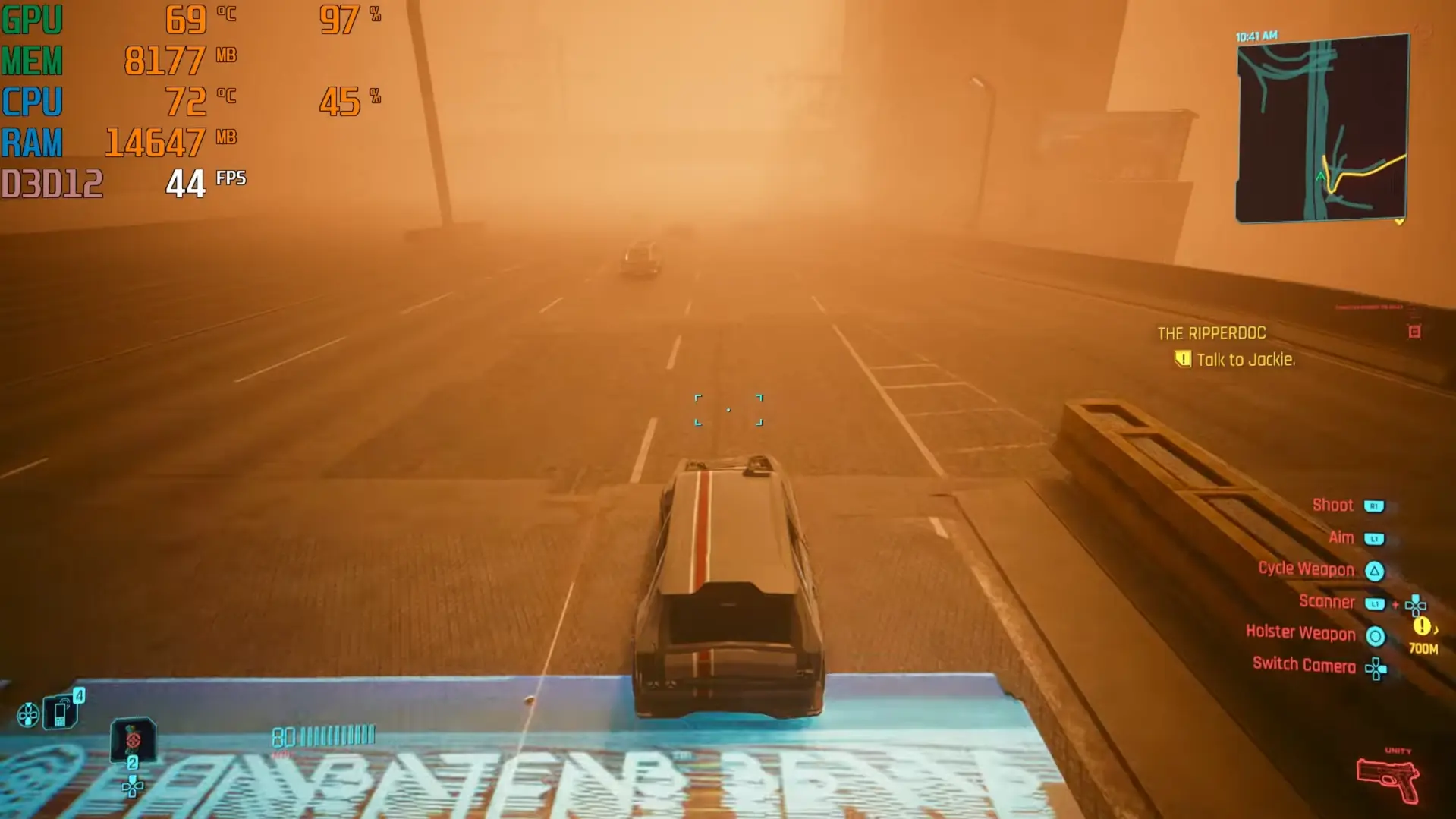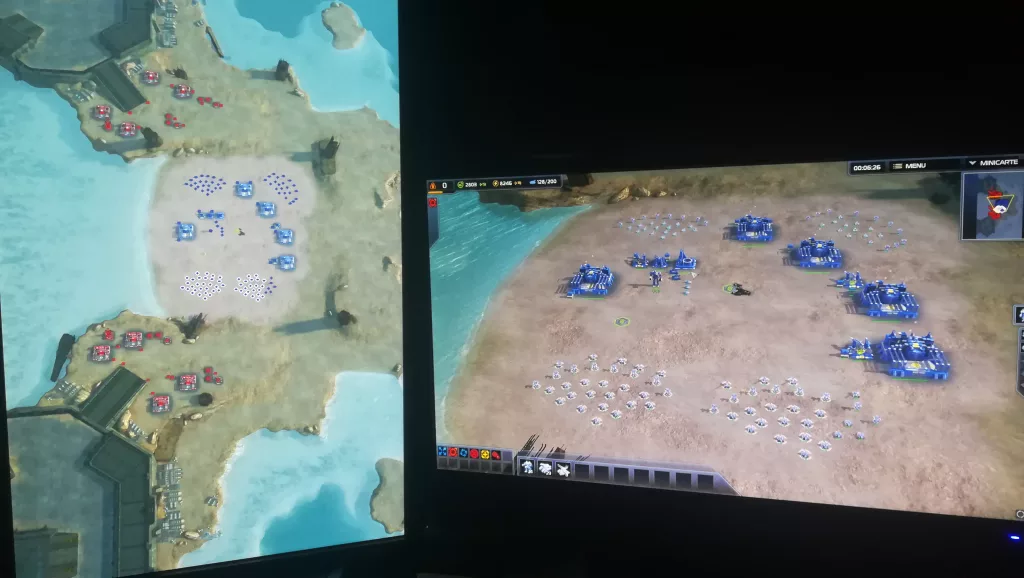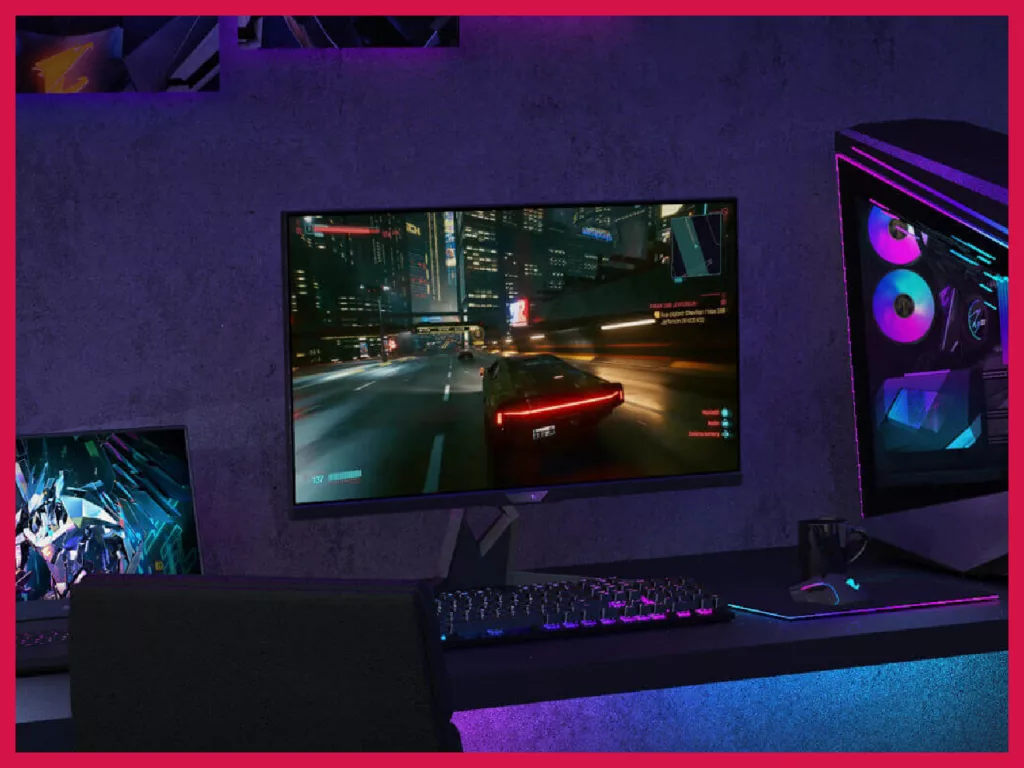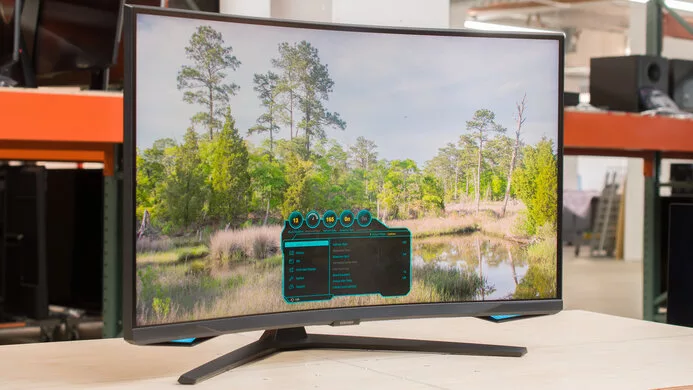Ever squinted at your gaming monitor, wondering if those acronyms FPS and Hz actually matter? Or maybe you’ve heard the terms thrown around in online forums, but you’re still not quite sure what they mean or why you should care.
TL;DR: The FPS is the count of how many frames your rig (mainly the GPU) can produce in-game at your current settings. The Hz is the monitor’s intrinsic property of how many frames it can display. Even if you’re rendering 300 frames a second with an RTX 3090 but using a 144 Hz monitor, you’re wasting 300-144 = 156 frames.
FPS (frames per second) and refresh rate (Hz) are two key factors that can significantly impact your gaming experience. Think of them as the dynamic duo of display technology. One determines how many images your computer can generate each second, while the other dictates how often your monitor can refresh those images.
In this guide, we’ll break down the differences between FPS and Hz, explain why they’re important for gamers, and even help you figure out the sweet spot for your setup. We’ll ditch the tech jargon and keep things simple, so you can focus on what really matters: enjoying your games to the fullest.
What is FPS?
Alright, let’s break down this FPS thing once and for all. FPS stands for frames per second, and it’s basically a measure of how many still images (frames) your gaming rig can spit out and display on your screen every single second.
Imagine you’re watching a flipbook animation. Each page is a frame, and the faster you flip through them, the smoother the animation appears. FPS works in the same way. The more frames your PC can generate and your monitor can display per second, the smoother and more fluid your gameplay will feel.
A higher FPS means your game is updating more frequently, which translates to less input lag, more responsive controls, and an overall smoother gaming experience. It’s like the difference between watching a slideshow and a high-definition movie. One is choppy and jarring, while the other is smooth and immersive.
Now, you might be wondering, “What’s a good FPS?” Well, the answer isn’t as simple as a single number. It depends on various factors, including the type of game you’re playing, your personal preferences, and your monitor’s refresh rate (which we’ll get to in a bit).
Generally speaking, 30 FPS is considered the bare minimum for playable gameplay. However, most gamers aim for at least 60 FPS for a smooth and enjoyable experience. And for fast-paced competitive games, higher frame rates like 120 FPS or even 240 FPS can give you a significant advantage over your opponents.
But remember, FPS isn’t the only factor that affects your gaming experience. It’s just one piece of the puzzle. And to truly understand how FPS works, we need to talk about its partner in crime: refresh rate.
What is Refresh Rate (Hz)?
If FPS is the number of frames your PC spits out, then refresh rate (measured in Hertz or Hz) is how fast your monitor can catch them. It’s like a baseball game: your graphics card is the pitcher hurling frames, and your monitor is the catcher trying to snag them all.
Refresh rate is simply the number of times your monitor’s screen refreshes or redraws itself each second. So, a 60Hz monitor refreshes 60 times per second, a 144Hz monitor refreshes 144 times, and so on. The higher the refresh rate, the more often your monitor updates the image, resulting in smoother motion, reduced blurring, and an overall clearer picture.
Imagine watching a car chase scene. With a low refresh rate monitor, the cars might look like they’re stuttering or jumping across the screen. But with a higher refresh rate, the action is buttery smooth, making it easier to follow the chase and feel immersed in the scene.
But wait, there’s more! A high refresh rate monitor can also make your games feel more responsive. That’s because there’s less delay between when your PC sends a new frame and when your monitor displays it. This reduced input lag can be a game-changer, especially for fast-paced competitive games where split-second reactions are crucial.
Now, don’t get too hung up on chasing the highest refresh rate possible. While higher is generally better, there’s a point of diminishing returns. Most people won’t notice a huge difference between a 144Hz and a 240Hz monitor, especially if their graphics card can’t consistently deliver that many frames per second.
So, the ideal refresh rate for you depends on a few factors, including your budget, the type of games you play, and your graphics card’s capabilities. But as a general rule of thumb, a 144Hz monitor is a sweet spot for most gamers, offering a noticeable improvement over 60Hz without breaking the bank.
How is FPS Related to Refresh Rate?
Alright, so we’ve got these two numbers, FPS and Hz, each representing how fast your gaming rig and monitor are working. But how do they actually interact to create that silky-smooth gameplay we all crave?
Imagine your graphics card is a tireless artist, churning out beautiful paintings (frames) at a rapid pace. Your monitor is the gallery wall, displaying these masterpieces for your viewing pleasure. Now, the refresh rate is how quickly the gallery owner can swap out the old paintings for new ones.
If your artist (GPU) is painting faster than the gallery owner (monitor) can replace the artwork, you’re going to have a backlog of paintings piling up. This leads to a phenomenon called “screen tearing,” where the image on your screen appears to split horizontally, with different parts of the image showing different frames. It’s like trying to watch two movies at once – a real eyesore.
On the other hand, if your gallery owner is replacing paintings faster than your artist can create them, you’ll have empty frames on your wall. This results in stuttering, where the image appears to freeze momentarily before jumping ahead. It’s like watching a movie with missing scenes – disorienting and frustrating.
The ideal scenario is when your artist and gallery owner are perfectly in sync. Your GPU is generating frames at the same rate your monitor is refreshing the screen. This harmony creates a smooth, tear-free, and stutter-free gaming experience.
But here’s where things get interesting: Your GPU doesn’t always generate frames at a constant rate. It fluctuates depending on the complexity of the scene, the game’s settings, and even the ambient temperature. This means your FPS can vary throughout your gaming session.
So, what happens when your FPS exceeds your monitor’s refresh rate? Well, that’s where technologies like Vsync and adaptive sync come into play. They help synchronize your GPU and monitor, ensuring that frames are delivered at the right time and preventing tearing and stuttering.
In the end, it’s all about finding the right balance between FPS and refresh rate. A high refresh rate monitor is useless if your GPU can’t keep up, and a powerful GPU won’t shine if your monitor is holding it back.
Impact of FPS and Hz on Gameplay
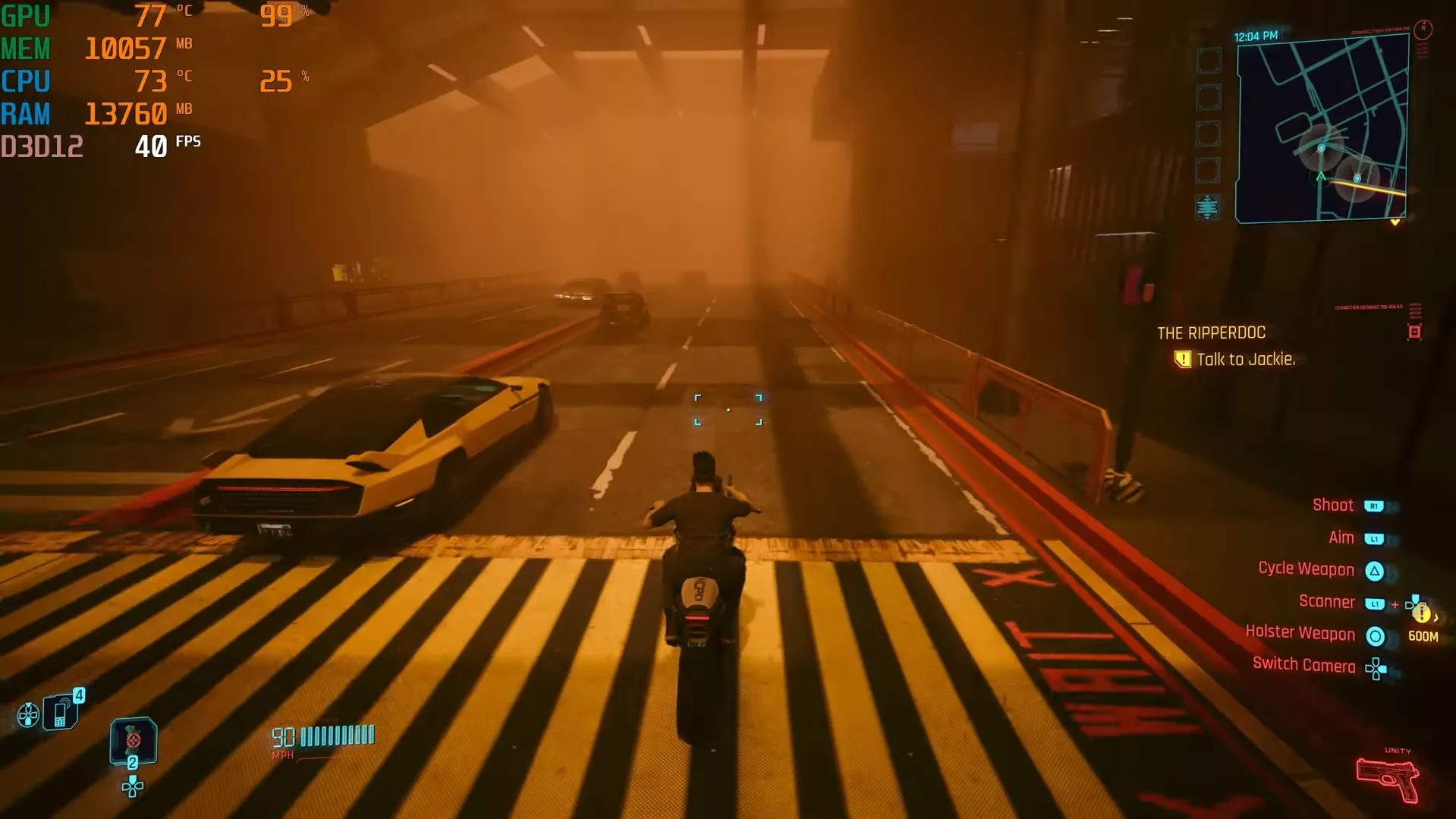
Let’s be honest, tech specs can be a snooze fest. But understanding how FPS and Hz actually impact your gameplay? That’s where things get exciting. There are three main scenarios. You want to have the third one. But let’s talk about them all.
High FPS, Low Hz: Unfulfilled Potential
Picture this: you’ve got a gaming rig that can crank out 200 FPS in Cyberpunk 2077. But your monitor is stuck at 60Hz. What happens? Well, your PC is working overtime, rendering all those extra frames, but your monitor can only show you 60 of them each second. It’s like having a sports car on a dirt road – you’re not getting the full experience. You might notice slight improvements in input lag, but the visuals won’t be as smooth as they could be.
Low FPS, High Hz: Waiting Game
Now, let’s flip the script. You’ve got a blazing-fast 240Hz monitor, but your PC is struggling to hit 60 FPS in most games. In this scenario, your monitor is ready to party, but your GPU is the one holding things up. You’ll see smooth motion between the few frames your PC can deliver, but the overall experience will be choppy and unsatisfying.
Matching FPS and Hz: The Goldilocks Zone
The magic happens when your FPS and Hz are in harmony. This is the sweet spot. When your graphics card is pumping out frames at the same rate your monitor is refreshing, you get the smoothest, most responsive gaming experience possible. It’s like a synchronized dance between your PC and monitor, resulting in gameplay that feels incredibly fluid and immersive.
In this ideal scenario, you’ll see:
- Reduced Input Lag: Your actions translate to on-screen movement more quickly, giving you a competitive edge.
- Smoother Motion: Objects and characters move more fluidly across the screen, reducing eye strain and making it easier to track fast-moving targets.
- Elimination of Screen Tearing: No more ugly visual artifacts ruining your immersion.
- Clearer Visuals: Fast-moving objects appear sharper and less blurry, allowing you to see more detail.
The ideal FPS and Hz combo varies depending on the game and your personal preferences. But as a general rule of thumb, matching your monitor’s refresh rate with your GPU’s average FPS is a good starting point. If your FPS is lower than the Hz, it might be time to turn down those settings or upgrading your GPU.
Choosing the Right Monitor
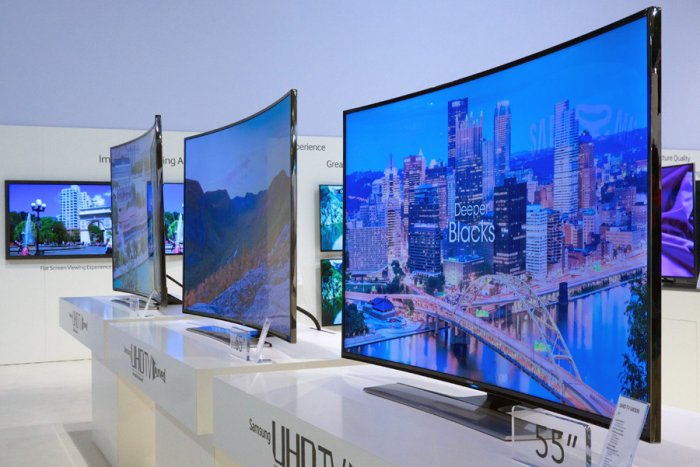
Alright, so we’ve covered the basics of FPS and refresh rate. Now comes the fun part: picking out a monitor that’ll make your games look as buttery smooth as they feel.
Think of it like choosing a car. You wouldn’t buy a Ferrari if you only drove to the grocery store, right? Similarly, you don’t need a top-of-the-line gaming monitor if your PC struggles to hit 60 FPS. So, let’s figure out what you actually need.
Refresh Rate
The refresh rate is arguably the most crucial factor for gamers. As we’ve already established, a higher refresh rate means smoother motion and reduced input lag. But how high should you go?
- 60Hz: This is the baseline. It’s fine for casual gaming or everyday use, but you’ll definitely notice a difference with a higher refresh rate.
- 75Hz – 100Hz: A small but noticeable step up from 60Hz, offering slightly smoother motion.
- 120Hz – 144Hz: This is the sweet spot for most gamers. It delivers a significant improvement in smoothness and responsiveness without breaking the bank.
- 240Hz+: For the hardcore competitive crowd. It offers the absolute smoothest experience but comes with a hefty price tag.
Resolution
Next up is resolution, the number of pixels that make up your monitor’s image. The higher the resolution, the sharper and more detailed the image.
- 1080p: The most common resolution, offering a good balance between performance and visual quality.
- 1440p: A step up from 1080p, with more detailed visuals. Requires a more powerful GPU to maintain high frame rates.
- 4K: The king of resolution, delivering stunning visuals but demanding a top-tier GPU to run smoothly, especially if you also want ray tracing.
- 8K: Not realistic unless if you have a lot of money to throw around.
Panel Type
Panel type affects color accuracy, viewing angles, and response times.
- IPS: Offers the best color accuracy and viewing angles, ideal for content creation and immersive gaming.
- TN: Boasts the fastest response times, making it popular for competitive gaming where every millisecond counts.
- VA: Offers a good balance between color accuracy and response times, a decent all-rounder, but image quality is lower than IPS.
Adaptive Sync
Adaptive sync technologies like Nvidia G-Sync and AMD FreeSync help eliminate screen tearing by synchronizing your monitor’s refresh rate with your GPU’s output. Choose the one that’s compatible with your graphics card.
Budget
Let’s be honest, gaming monitors can get pricey. So, set a realistic budget before you start shopping. Remember, a good 1080p or 1440p monitor with a high refresh rate will often offer a better gaming experience than a 4K monitor with a lower refresh rate, especially if your GPU can’t handle the extra pixels.
The GPU
Finally, remember that your monitor’s capabilities are only half the equation. Your graphics card needs to be able to pump out enough frames to take advantage of a high refresh rate. There’s no point in having a 240Hz monitor if your GPU can only manage 60 FPS.
Common Misconceptions About FPS and Hz
There’s a lot of incorrect information and bad assumptions about displays, refresh rates, and their connection to the in-game FPS. Let’s try to bust a few of these myths.
- Myth #1: Higher FPS Always Means a Better Gaming Experience: Hold your horses there, speed demon! While a higher FPS generally translates to smoother gameplay, it’s not the be-all and end-all of gaming performance. Your monitor’s refresh rate plays a crucial role too. If your monitor is capped at 60Hz, cranking your FPS to 200 won’t magically make your games look smoother. It’s like pouring a gallon of water into a pint glass – you’re just wasting resources.
- Myth #2: Hz and FPS Are the Same Thing: Nope, they’re not interchangeable, though they are BFFs. FPS is how many frames your PC generates, while Hz is how often your monitor refreshes the screen. Think of it like this: FPS is the supply, and Hz is the demand. They need to be in sync for optimal performance.
- Myth #3: You Need a High-End PC for a High Refresh Rate Monitor: Not necessarily! While a powerful GPU is definitely helpful for pushing those high frame rates, you can still benefit from a high refresh rate monitor even with a modest gaming rig. Games that aren’t graphically demanding can often run at high frame rates even on older hardware. So, don’t let your budget hold you back from enjoying smoother gameplay.
- Myth #4: Vsync is Always the Answer: Vsync can be a useful tool for eliminating screen tearing, but it’s not always the best solution. It can introduce input lag and potentially limit your FPS if your GPU can’t consistently match your monitor’s refresh rate. Thankfully, adaptive sync technologies like G-Sync and FreeSync offer a more elegant solution by dynamically adjusting the monitor’s refresh rate to match your GPU’s output.
- Myth #5: More Hz is Always Better: While a higher refresh rate generally means smoother visuals, there’s a point of diminishing returns. Most people won’t notice a huge difference between a 144Hz and a 240Hz monitor, especially if their eyes can’t keep up with the action. So, don’t feel pressured to buy the most expensive monitor with the highest refresh rate. Find a sweet spot that balances your needs, budget, and GPU capabilities.
And that’s it. The two things are connected closely and affect your gameplay in the most considerable way after in-game settings themselves. Hopefully, you learned a thing or two here! A good read to follow this up is either how to improve your gaming performance for free and how to boost in-game FPS with some realistic tips.
FAQs
How many FPS will a gaming monitor give?
Your monitor doesn’t actually give you FPS; it only displays the frames your graphics card generates. Think of it like this: your GPU is the chef cooking up delicious frames, and your monitor is the plate serving them up. The monitor’s refresh rate (Hz) determines how often it can change the “plates,” but the amount of food (FPS) is determined by the chef.
Will a better monitor increase FPS?
Nope! A fancy monitor won’t magically boost your FPS. That’s the graphics card’s job. However, a better monitor with a higher refresh rate can display more of those frames, resulting in smoother, more responsive gameplay. It’s like upgrading from a tiny appetizer plate to a full-sized dinner plate – you can enjoy more of that delicious food (frames) at once.
What happens if your refresh rate is higher than FPS?
If your refresh rate is higher than your FPS, your monitor will refresh faster than your GPU can deliver new frames. This can lead to a phenomenon called “stuttering,” where the image appears to freeze momentarily before jumping ahead. It’s like watching a movie where some frames are missing – not exactly a smooth experience.
Can I get 100 FPS on a 60Hz monitor?
Yes, your PC can definitely generate 100 FPS, even if your monitor is only 60Hz. However, you won’t be able to see all those extra frames. Your monitor will only display 60 frames per second, regardless of how many your GPU is producing. It’s like having a super-fast chef but a slow waiter – the food will still be delicious, but it won’t arrive as quickly as it could.


